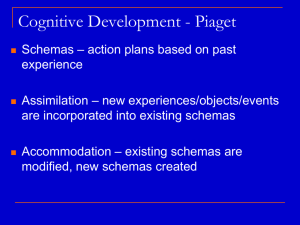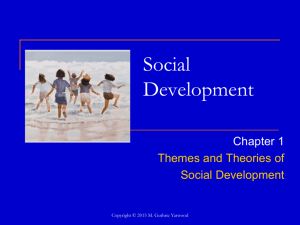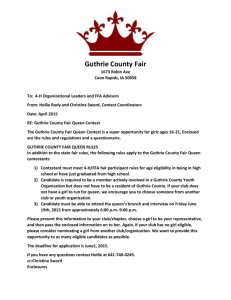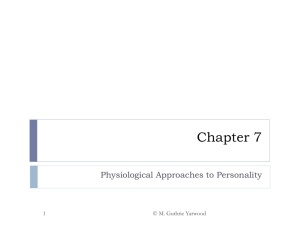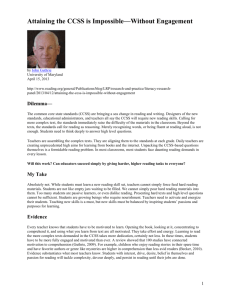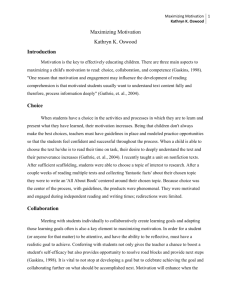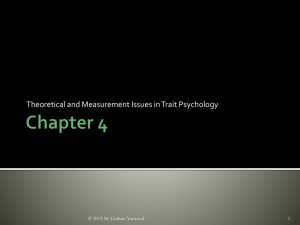Chapter 12 For Oct. 21/23 Class
advertisement
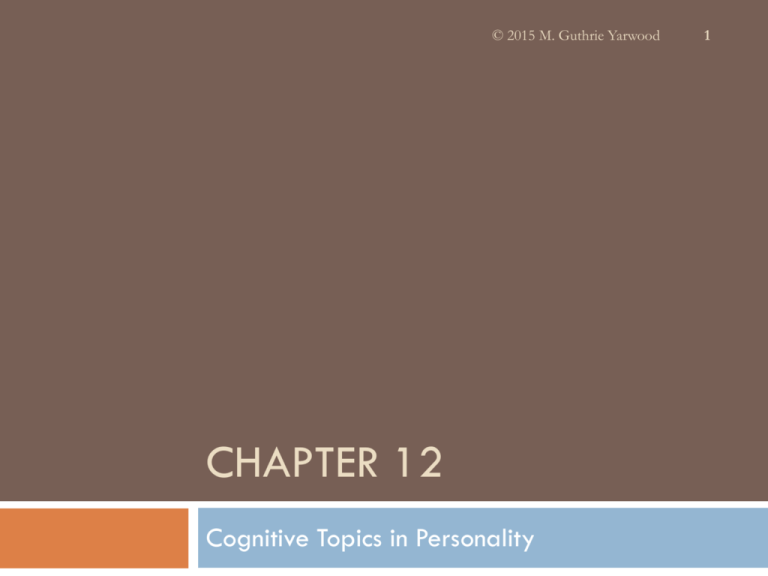
© 2015 M. Guthrie Yarwood CHAPTER 12 Cognitive Topics in Personality 1 Part II. The Cognitive/Experiential Domain 2 Cognitive Experiences Emotions © 2015 M. Guthrie Yarwood Individual Differences in Cognition 3 Individual differences in how people process information Perception Interpretation Goals © 2015 M. Guthrie Yarwood Individual Differences in Perception 4 Field Dependence-Independence Theory Reducer-Augmenter Theory © 2015 M. Guthrie Yarwood Field Dependence-Independence (Witkin,1962) 5 Field Dependent Perceptions of environment based on external cues from the environment (“the field”). Field Independent Perceptions of environment based on internal cues from their own bodily sensations. © 2015 M. Guthrie Yarwood 6 Measuring field independence Rod and Frame Test (RFT) © 2015 M. Guthrie Yarwood Measuring field independence 7 Embedded Figures Test (EFT) © 2015 M. Guthrie Yarwood Dependent or Independent? 8 1. More attentive to social cues 2. Greater Responsibility-taking, more self-reliant 3. Warm, affectionate, tactful, accepting of others 4. 5. Demanding, inconsiderate, manipulative, cold and distant in relationships Shows Initiative © 2015 M. Guthrie Yarwood Field Dependence-Independence: What does research say? 9 Education: Field independent: natural sciences, math, engineering, language Field dependent: social sciences and education Careers: Field independent officers performed better on shooting task and gave more accurate description of critical event © 2015 M. Guthrie Yarwood Reducer-Augmenter Theory (Petrie) 10 People differ in their reactions to sensory stimulation Reducers: Nervous system dampens, or “reduces,” the effects of sensory stimulation. Augmenters: Nervous system amplified, or “augments,” the subjective impact of sensory cues. © 2015 M. Guthrie Yarwood For each pair of activities or events, choose the response that best indicates your preference: 11 1 2 3 4 5 6 Hard Rock Music Soft Pop Music Action Movies Comedy Movies Contact Sports Noncontact Sports A drum solo A flute solo Too much exercise Too Little Exercise Augmenters Reducers © 2015 M. Guthrie Yarwood Reducer-Augmenter Theory (Petrie) 12 Ex: Individual Difference in Pain Tolerance: when people undergo same physical stimulus, but react differently to the stimulus (report a different level of pain). Low Pain Tolerance Augmenters High Reducers © 2015 M. Guthrie Yarwood Research Says! 13 Reducers show relatively small brain responses to flashes of light and bursts of noise compared to augmenters Reducers seek strong stimulation, drink more coffee, smoke more, and have a lower threshold to become bored Reducers tend to start smoking at an earlier age, and to engage in minor delinquencies as adolescents © 2015 M. Guthrie Yarwood Match similar terms together! 14 Reducer Augmenter Field-Independence Field-Dependence Extraversion Introversion Psychology Students © 2015 M. Guthrie Yarwood INTERPRETATION Individual Differences in Interpretation 15 Individual differences that determine our construal of the world © 2015 M. Guthrie Yarwood 16 © 2015 M. Guthrie Yarwood Client names a set of 10 to 20 people who are important in his/her life. 17 © 2015 M. Guthrie Yarwood Significant Other An ex Myself 18 Researcher selects 3 elements (people) and asks client which 2 elements are similar and which element is different? © 2015 M. Guthrie Yarwood Significant Other An ex Myself Client provides label for similarity. Laid-back 19 © 2015 M. Guthrie Yarwood Significant Other An ex Myself Client provides label for difference. Laid-back 20 © 2015 M. Guthrie Yarwood Nervous Significant Other An ex Myself Label for similarity and label for difference make up similarity-contrast construct. Laid-back 21 © 2015 M. Guthrie Yarwood Nervous Kelly’s Personal Construct Theory 22 Construct Systems: personal theories that help us to understand, control and predict life events. The ways in which people describe the self and others (i.e., adjectives) shows how people interpret the world. Personal constructs: Mature------Childish Bad influence-----------Mentor Oddball-----------Mainstream © 2015 M. Guthrie Yarwood Rotter’s Locus of Control: How responsible are you for the events that occur in your life? 23 External Internal Events are outside the person’s control Events are under the person’s control Even if I study (behavior), I may not receive an A. **Failure Expectancy If I study (behavior), then I will receive an A. **Achievement/Success Expectancy © 2015 M. Guthrie Yarwood Example Items-Which are External or Internal? 24 #2 Many of the unhappy things in people's lives are partly due to bad luck. People's misfortunes result from the mistakes they make. #10 In the case of the well prepared student there is rarely if ever such a thing as an unfair test. Many times exam questions tend to be so unrelated to course work that studying in really useless. © 2015 M. Guthrie Yarwood Learned Helplessness 25 2-Part Study © 2015 M. Guthrie Yarwood Learned Helplessness 26 Explanatory style: The way in which people explain (“attribute”) bad or good events that happen in their lives External or internal Stable or unstable Global or specific © 2015 M. Guthrie Yarwood 27 Internal vs. External • Did I or an outside force cause this event? Stable vs. Unstable • Will this good or bad event happen again? Universal vs. Specific • Is this good or bad event a reflection of my global self or a specific life domain? © 2015 M. Guthrie Yarwood Bad Event 28 Optimist • External • Unstable • Specific Pessimist • Internal • Stable • Universal © 2015 M. Guthrie Yarwood Good Event 29 Optimist • Internal • Stable • Universal Pessimist • External • Unstable • Specific © 2015 M. Guthrie Yarwood On Spring Break in Vegas, Alan wins $3,000 playing blackjack. Alan is a pessimist. How would Alan explain the reason for his winnings? 30 On Spring Break in Vegas, Kate wins $3,000 playing blackjack. Kate is an optimist. How would Kate explain the reason for her winnings? © 2015 M. Guthrie Yarwood Meg received a D on her psychology mid-term. Meg is a pessimist. How would Meg explain the reason for her poor grade? 31 Calvin received a D on his psychology midterm. Calvin is an optimist. How would Calving explain the reason for his poor grade? © 2015 M. Guthrie Yarwood Need for Cognition (Cacioppo & Petty, 1982) 32 Individual difference variable in interpretation Need to understand and explain the world © 2015 M. Guthrie Yarwood NFC- Example Items 33 I would prefer complex to simple problems. Thinking is not my idea of fun. R I feel relief rather than satisfaction after completing a task that required a lot of mental effort. R The notion of thinking abstractly is appealing to me. © 2015 M. Guthrie Yarwood Need for Cognition is positively correlated with: 34 A. B. C. D. E. Agreeableness Conscientiousness Emotional Stability Openness to Experience Extraversion © 2015 M. Guthrie Yarwood For each print ad… 35 1. What was the product? 2. What was the brand? 3. What did the ad claim? © 2015 M. Guthrie Yarwood Individual Differences in Goals 36 People differ in their goals, and these differences are part of personality © 2015 M. Guthrie Yarwood Dweck: Lay Theories of Intelligence 37 Entity Theory Incremental Theory • Intelligence is a fixed internal characteristic • People cannot change their intelligence level • Intelligence is not fixed and is changeable • Intelligence can improve through effort, persistence, etc. © 2015 M. Guthrie Yarwood Knee: Lay Theories of Relationships (ITRs) 38 Destiny Theory • Entity theory • Relationship is or is not meant to last Growth Theory • Incremental Theory • Relationships can be improved and worked on © 2015 M. Guthrie Yarwood(Knee, Patrick, & Lonsbary, 2003) ITR: Example Items: Growth or Destiny? 39 1. 2. 3. 4. The ideal relationship develops gradually over time. Problems in a relationship can bring partners closer together. Relationships that do not start off well inevitably fail. Potential relationship partners are either destined to get along or they are not. © 2015 M. Guthrie Yarwood ITR: Example Items: Growth or Destiny? 40 The ideal relationship develops gradually over time. G Life Outcomes? Favorable? Unfavorable? Problems in a relationship can bring partners closer together. G Relationships that do not start off well inevitably fail. D Potential relationship partners are either destined to get along or they are not. D © 2015 M. Guthrie Yarwood 41 Growth Destiny Fewer one night-stands If believe RR is meant to be, then RR lasts long time More time dating same person If problem arises early on, more likely to terminate More likely to repair relationship when problems arise If initial satisfaction/closeness is low, more likely to terminate Greater use of ineffective coping strategies © 2015 M. Guthrie Yarwood ITRs and Big Five 42 Destiny Growth © 2015 M. Guthrie Yarwood Growth Destiny ↑ Conscientiousness ↑ Openness to Experience ↑ Agreeableness ↑ Extraversion ↑ Neuroticism 43 © 2015 M. Guthrie Yarwood Higgins: Theory of Regulatory Focus 44 Promotion Focus • Focused on advancement, growth, accomplishments • Behaviors = eagerness, approach Prevention Focus • Focused on protection, safety, prevention of negative outcomes and failures • Behaviors = vigilance, caution, attempts © 2015 M. Guthrie Yarwood Focus determines motivation 45 Promotion-Focus “If you solve 22 of the 25 anagrams, you will play Wheel of Fortune” Prevention Focus “If you get 4 or more of the 25 anagrams wrong, you will play the unvaried repetition task” DV = Time spent working on unsolvable anagrams © 2015 M. Guthrie Yarwood Higgins: Theory of Regulatory Focus Positively correlated with E and Behavioral Activation 46 Promotion Focus • Focused on advancement, growth, accomplishments • Behaviors = eagerness, approach Prevention Focus • Focused on protection, safety, prevention of negative outcomes and failures • Behaviors = vigilance, caution, attempts Positively correlated with © 2015 M. Guthrie Yarwood N and Harm Avoidance
